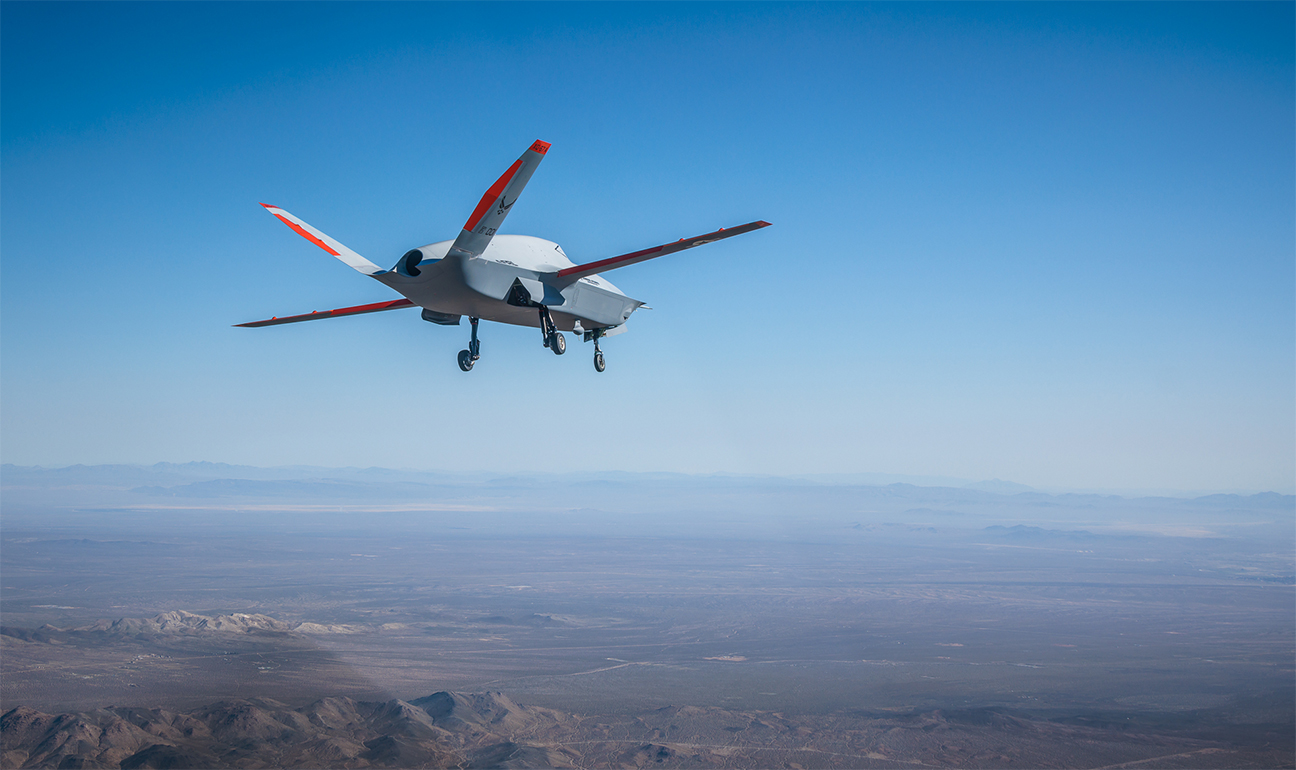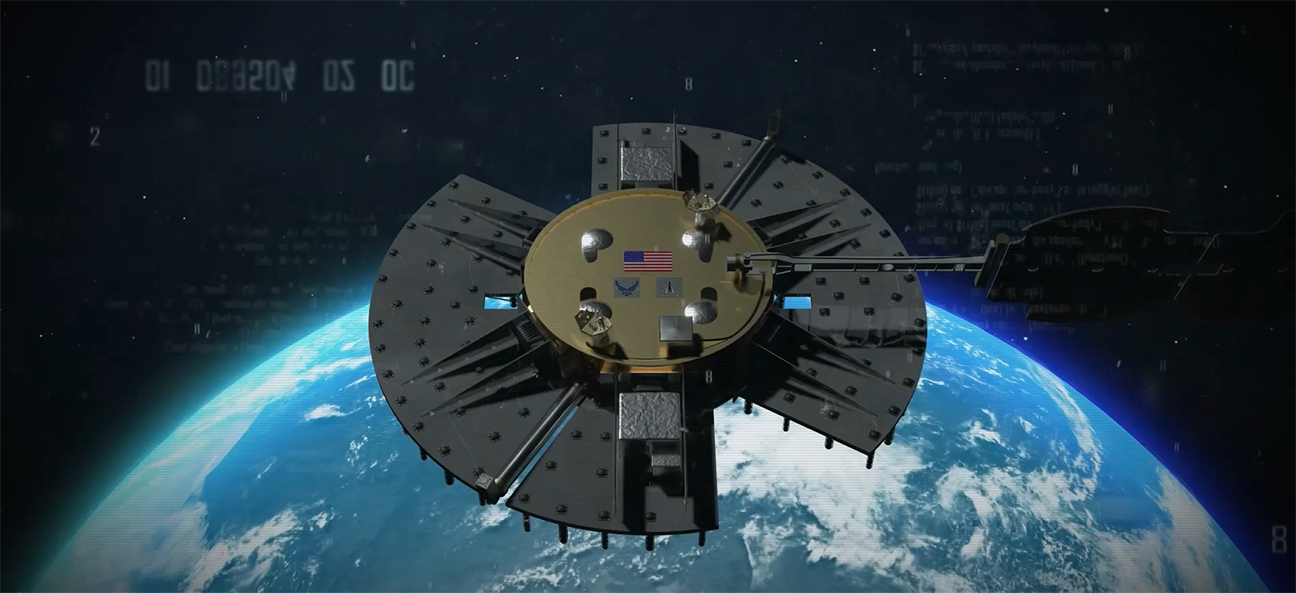AFRL to highlight tech at 2024 Air, Space and Cyber Conference
WRIGHT-PATTERSON AIR FORCE BASE, Ohio (AFRL) – The Air Force Research Laboratory, or AFRL, will showcase war-winning technologies to drive the future fight in an era of Great Power Competition at the Air and Space Forces Association’s Air, Space and Cyber Conference, or AFA ASC, Sept. 16-18, 2024, at the Gaylord National Hotel and Convention Center in National Harbor, Maryland.
This year’s conference theme is “Achieving Decisive Advantage in an Age of Growing Threats.”
AFRL will showcase six examples of integrated capabilities as part of its 2024 “Engine to Accelerate” exhibit booths in the conference center’s Prince George Exhibit Hall. These examples will highlight a deliberate combination of technologies that are helping to deliver capabilities to the warfighter more quickly and efficiently.

The Air Force Research Laboratory, or AFRL’s, XQ-67A Off Board Sensing Station uncrewed air vehicle, designed and built by General Atomics, takes its maiden flight Feb. 28, 2024, from Gray Butte Field Airport in Palmdale, California. The XQ-67A’s first flight was made possible due in large part to Low Cost Attritable Aircraft Platform Sharing, or LCAAPS, which AFRL will showcase at its “Engine to Accelerate” booths at the 2024 Air and Space Forces Association’s Air, Space and Cyber Conference Sept. 16-18, 2024, in National Harbor, Maryland. LCAAPS leverages best practices of consumer industries to rapidly develop and build autonomous collaborative platforms in large numbers, with the goal of achieving affordable mass by streamlining the design and development process. The XQ-67A, the first of a second generation of autonomous collaborative platforms, proves the feasibility of this approach and demonstrates how wholly new acquisition processes can deliver capability to the warfighter more quickly and efficiently. (Courtesy photo)
“Science and technology run deep in the Department of the Air Force’s history and are vital to our future,” said Brig. Gen. Jason Bartolomei, AFRL commander. “The lab is focused on high-impact, multi-domain S&T solutions that move the needle right now while laying the groundwork for the Air and Space Force to win the future fight.”
AFWERX, the innovation arm of the U.S. Department of the Air Force and powered by AFRL, will also display a “Spark Street” exhibit in the conference center’s Maryland Exhibit Hall, which will showcase Airman and Guardian innovations from Spark Cells around the world. Spark is a compelling example of an initiative that allows AFRL to deliver science and technology to the warfighter at the speed of need.
At AFRL’s “Engine to Accelerate” booths, conference attendees can learn about Grasshopper, a cost-efficient, air-dropped, autonomously-navigated glider that delivers materiel to operators on the ground. The program leverages low-cost manufacturing techniques to keep production costs at approximately $40,000 per vehicle to provide an asymmetric capability for cargo delivery. The Grasshopper team is accelerating the capability timeline by establishing a close interaction between AFRL and Air Force Special Operations Command users that facilitates immediate customer feedback and rapid flight testing.
AFRL will also display Navigation Technology Satellite-3, or NTS-3, an experimental platform designed to demonstrate technologies to increase resiliency, robustness and reprogrammability of Position, Navigation, and Timing functionality in space. AFRL is accelerating innovation by transforming the satellite navigation architecture to be reprogrammable both on-orbit and in the field, which enables new capabilities to support the warfighter faster through software updates. Like downloading a new app on your smartphone, this means that new satellites will not need to be launched to upgrade the signals, and that warfighters will not need to purchase and deploy new hardware to take advantage of upgraded signals. NTS-3 will mature technologies like the advanced timekeeping system that can detect and mitigate atomic clock faults without direct operator intervention. NTS-3’s software-defined receiver, known as Global Navigation Satellite System Test Architecture, can receive and process new navigation signals that improve performance for U.S. forces in the presence of GPS interference or spoofing (a process by which users are sent inaccurate signals telling them that they are in the incorrect time and place). NTS-3 is anticipated to launch in late 2024.

An artistic rendering depicts the Air Force Research Laboratory, or AFRL’s, Navigation Technology Satellite-3, or NTS-3, in simulated geosynchronous orbit. NTS-3, an experimental platform designed to demonstrate technologies to increase resiliency, robustness and reprogrammability of Position, Navigation, and Timing functionality in space, will be on display at AFRL’s “Engine to Accelerate” booths at the 2024 Air and Space Forces Association’s Air, Space and Cyber Conference Sept. 16-18, 2024, in National Harbor, Maryland. AFRL is accelerating innovation by transforming the satellite navigation architecture to be reprogrammable both on-orbit and in the field, which enables new capabilities to support the warfighter faster through software updates. Like downloading a new app on your smartphone, this means that new satellites will not need to be launched to upgrade the signals, and that warfighters will not need to purchase and deploy new hardware to take advantage of upgraded signals. NTS-3 will mature technologies like the advanced timekeeping system that can detect and mitigate atomic clock faults without direct operator intervention. NTS-3’s software-defined receiver, known as Global Navigation Satellite System Test Architecture, can receive and process new navigation signals that improve performance for U.S. forces in the presence of GPS interference or spoofing (a process by which users are sent inaccurate signals telling them that they are in the incorrect time and place). NTS-3 is anticipated to launch in late 2024. (Courtesy photo illustration)
Additionally, visitors to AFRL’s exhibit booths can learn more about AEROMORPH, an AFRL University Center of Excellence, or UCoE, that performs fundamental multidisciplinary research to endow future supersonic and hypersonic weapons with game-changing performance through active morphing without significant size, weight or power penalties. UCoEs provide opportunities to document scientific understanding and develop future scientists who contribute to AFRL’s mission. AEROMORPH’s unique approach is to embed a self-contained sense-assess-response morphing process into the material and structure. With AFRL’s strategic foresight, the AEROMORPH UCoE lays the foundation for transition of active morphing in high-speed systems as an integrated capability to AFRL, becoming the basis for future AFRL programs that enable the warfighter to outpace our adversaries through superior weapons performance and Air Superiority.
Missile Utility Transformation via Articulated Nose Technology, or MUTANT, will also be on display. MUTANT is an articulation control actuation system technology that increases missile effectiveness at longer range against moving targets through active, rapid and smooth pivoting of the missile forebody. This enables the warfighter to destroy air targets at scale, with higher confidence and fewer weapons. MUTANT is actively working to transition this technology and enable warfighter use.
AFRL will also highlight Low Cost Attritable Aircraft Platform Sharing, or LCAAPS, which leverages best practices of consumer industries to rapidly develop and build autonomous collaborative platforms in large numbers. LCAAPS’ goal is to achieve affordable mass by streamlining the design and development process. The XQ-67A, an Off-Board Sensing Station uncrewed air vehicle that saw its first successful flight in February 2024, proves the feasibility of this approach and demonstrates how wholly new acquisition processes can deliver capability to the warfighter more quickly and efficiently.
AFRL will feature the Gallium Nitride Device, or GaN, a semiconductor technology that marks a pivotal advancement in radio frequency sensing, enhancing radar, electronic warfare and communications capability ubiquitously across Department of Defense platforms. AFRL developed GaN materials and device technology internally and leveraged national programs to build a robust and needed domestic supply chain. AFRL now continues to co-develop GaN technology with industry, accelerating delivery of next generation sensing systems for the warfighter.
Lastly, in partnership with the Air Force Life Cycle Management Center, AFRL will feature full scale Collaborative Combat Aircraft (CCA) models. These are uncrewed weapon systems leveraging DAF investments in autonomy and crewed-uncrewed teaming to project air power against adversaries. Anduril’s model will be in booth #503 and the General Atomics model will be on display in booth #1834.
Bartolomei will participate in the Air Force Materiel Command’s “AFMC reoptimizes for Great Power Competition (GPC)” media roundtable discussion, intended to highlight current AFMC priorities and progress and to communicate the impacts of GPC, both seen and unseen, that enhance AFMC’s ability to develop, modernize and sustain the Air Force. Bartolomei will participate alongside the commanders of the Air Force Installation and Mission Support Center, Air Force Life Cycle Management Center, Air Force Nuclear Weapons Center, Air Force Sustainment Center and Air Force Test Center. This media event is scheduled for Wednesday, Sept. 18, 2024, from 9:45-10:15 a.m. EST in room Chesapeake A.
Additionally, two renowned AFRL subject matter experts are scheduled to participate in speaking engagements at the AFA ASC event. Alexis Bonnell, AFRL’s chief information officer and director of AFRL’s Digital Capabilities Directorate, will serve as a moderator in a “Hacking the Acquisition Bureaucracy” panel Sept. 16 from 1:40-2:20 p.m. EST in room Potomac D. Bonnell will also serve as a panelist in a discussion titled “The AI Passport,” scheduled Monday, Sept. 16 from 3:20-4:00 p.m. EST in room Potomac D.
Dr. Michael Gregg, director of AFRL’s Aerospace Systems Directorate, will also serve as a panelist in a “21st Century Jet Propulsion Imperative” panel discussion slated for Sept. 18, from 8:00-8:40 a.m. EST in room Potomac D.
The AFA ASC conference is a premier professional development event for the U.S. Air and Space Forces, DOD personnel, the aerospace and defense industries and academia. It provides first-class professional military development, facilitates sharing of emerging requirements and technologies and helps fuel connections that advance the cause of air and space power.
For more information about AFRL’s programs and technologies, visit https://www.afresearchlab.com.
For more information about AFRL’s presence at the conference, visit https://afresearchlab.com/events/afa-air-space-cyber-conference-2024/.
NOTE FOR MEDIA: News Media Representatives who would like to schedule an interview with an AFRL subject matter expert during AFA ASC may contact Bryan Ripple, AFRL Public Affairs Media Operations team lead, at 937-469-1728 to request a meeting time.
About AFRL
The Air Force Research Laboratory is the primary scientific research and development center for the Department of the Air Force. AFRL plays an integral role in leading the discovery, development, and integration of affordable warfighting technologies for our air, space and cyberspace force. With a workforce of more than 12,500 across nine technology areas and 40 other operations across the globe, AFRL provides a diverse portfolio of science and technology ranging from fundamental to advanced research and technology development. For more information, visit afresearchlab.com.
